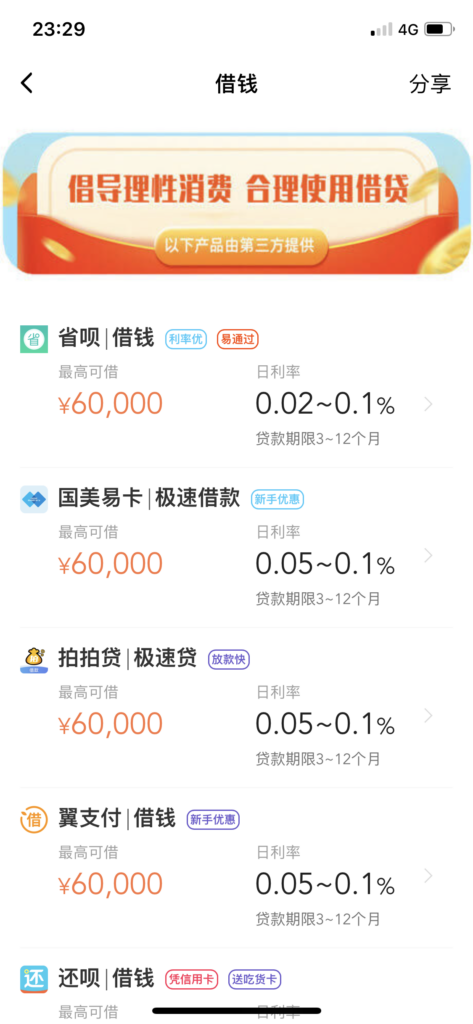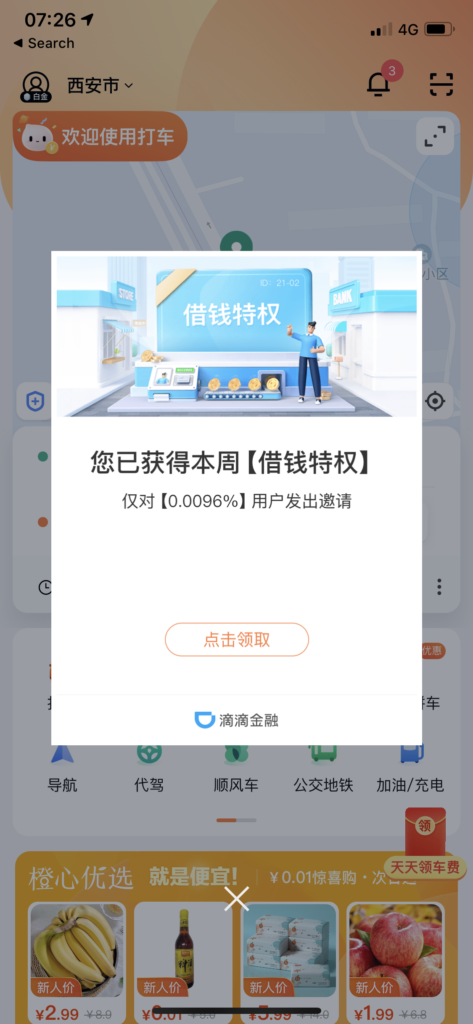Fintech lending is at peak proliferation in China. Among the top 50 most popular apps in China, 33 offer lending services in two main categories—payday loans and consumer credit services—according to a survey by Aurora Mobile, a mobile big data company. Even platforms that have nothing to do with finance, such as Douyin, news aggregator Toutiao, Baidu Maps, the self-descriptive WiFi Master Key, and microblog platform Weibo, are introducing their own loan services.
The apps in question have either developed their own microlending packages for checkout financing—installment loans that are offered at the point of purchase—or partner with financial institutions and platforms to leverage user traffic and behavioral data to lend money. Some even do both. Take Alibaba’s food delivery platform Ele.me as an example. It provides up to eight lending options backed by third-party vendors. Are we expected to take on extra debt when we order lunch?
Loan applications are fast and easy: simply register your national ID card and pass the facial recognition process by using your phone’s front-facing camera, and credit running anywhere between RMB 500 and 200,000 (USD 76 to 30,650) will be channeled your way. The exact amount depends on a user’s creditworthiness and loyalty to the platform as a customer.
Easy credit is just minutes away for eligible applicants, and that is by design. Many lending apps blur the real cost, slipping fees past anyone who doesn’t stop to look closely. Common practices include advertising daily interest rates rather than annual rates and using the word “minimum” without mentioning service fees up front. Most apps claim to charge the lowest annual interest at 7%, but take service fees into account and the real rate often falls within the range of 24% to 36%. Some even go as high as a nosebleed 50%.
Pervasive advertising campaigns extend the reach of predatory lenders. Many apps entice consumers to borrow money through pop-up ads or small discounts, “red packets” (free cash disbursement in small amounts), or free memberships for video streaming services.
Last year, a video ad for JD Finance drew intense criticism on social media. The clip featured a rural farmer and his mother on a flight who were unaccustomed to flying and experiencing airsickness. A fellow passenger offered to help them out by applying for a loan of RMB 150,000 yuan (USD 23,000) on his mobile phone. The idea was to spend the money on upgrading the mother’s ticket to first-class right then and there.
As unrealistic and outlandish as the scenario was, the ad made its point: phone-based lending is lightning fast. But what the public gleaned from that speed was how quickly someone can put themselves into debt. The problem is particularly severe when one considers how popular these apps are, and that so many people in China use them every day.

JD.com launched its first credit-based payment service, Bai Tiao, in 2014, giving customers the option to “buy now, pay later.” Since then, online installment loans have billowed out at a startling rate. Their usage has appeared in virtually every sector where an average consumer would spend their money—ride-hailing, restaurant dining, domestic and overseas travel, education, healthcare, cosmetic surgery, and more.
This leads to a slippery slope, where borrowers may take up multiple loans and spend beyond their means. In the past two years, stories about young people drowning in debt and abusive loan collection practices have entered the spotlight.
In 2019, an online discussion group named “Debtor Coalition” on Douban, a social networking website, quickly ballooned to more than 40,000 members in less than a year. People who join the Coalition are often in their 20s or 30s, and post about the debt they carry, negotiation tactics, and repayment plans. The idea behind the group is to create a space for communal aid, where members support each other in confronting what may feel like crushing debt and hopefully carve a way out of extremely unpleasant situations.
One recent post from March 23 showed how a single individual owed more than RMB 1.2 million (USD 183,000) to 13 creditors, including banks, web platforms, and private sources.
Many members say they routinely receive calls or messages from debt collectors that involve yelling, threats, and intimidation. Some even go further to contact the friends, relatives, and colleagues of debtors to shame them.
Nonetheless, online consumer loans are still emerging at an unparalleled pace. Simply put, there is more than enough demand.

Ant Group, which holds the largest share of China’s consumer finance market with 16%, revealed in its prospectus last year that its credit-based loan services Huabei and Jiebei had served more than 500 million users in 12 months—that’s 35% of the country’s total population.
Young adults who shop online use these services most often. A survey released in 2019 by Rong360, an online financial services platform, revealed that China’s post-90s generation accounts for 49.31% of online borrowers, and nearly 58% of them use loan services to pay for daily purchases. Chinese regulators are extremely concerned about the situation and are reining in online lenders.
Last year, China abruptly halted what was meant to be a record-breaking dual IPO of Ant Group, citing regulatory changes. New rules drafted by the China Banking and Insurance Regulatory Commission will come into effect on July 17, 2022. They will require microlenders to fund at least 30% of any credit they issue and slash the maximum size of individual loans.
Meanwhile, China is accelerating the inclusion of the massive troves of data generated from online lending into its national credit-scoring system, which tracks individuals’ and companies’ financial records to assess creditworthiness. Huabei, Ant’s main consumer credit product, was folded into the system in June last year, although not all customers are covered yet. The move is expected to cool down debt-fueled personal spending and overborrowing.
Industry analysts believe online lending no longer falls in a regulatory gray zone. For now, companies that poured resources into building microlending platforms must reset their pace to match the new regulatory environment. Hong Nuoxin, founder of online finance platform Xinfinance, said the threshold for entering the game is now higher. Under the new, unified rules, the days of fat profits and rapid growth are likely over.
With its massive population, mobile-ready consumers, and market-moving young spenders, China is a land of fintech innovation, where diverse financial products are rolled out and rapidly refined. But debt can mount quickly and become unmanageable, so a tempered way forward serves the greater good, just as the members of the Debtor Coalition have realized.

